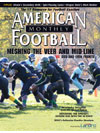AMERICAN FOOTBALL MONTHLY THE #1 RESOURCE FOR FOOTBALL COACHES
Article CategoriesAFM Magazine
|
Meshing the Veer and Mid-Line vs. Odd and Even FrontsWhen and why to use each option scheme based on front identificationby: Mike Kuchar © More from this issue It’s amazing what some old-fashioned ingenuity can do. For the most part, running the spread option usually means coming out of trips or four wide receiver shotgun sets and working some type of zone scheme-reading the backside end. It’s the type of option that is all over the collegiate landscape, with teams like Rich Rodriguez’s former West Virginia squad and Urban Meyer’s old Florida teams pioneering the movement. But as more programs decided to move to that scheme, many defenses found ways to combat it – either by stunting the end inside the B gap and looping the outside LB around, accounting for the speed of the QB with one of the defense’s quicker linebackers. Tom Green, formerly the head coach for seven years at Surrattsville High School in Maryland, and who recently took the same position in nearby Eleanor Roosevelt High....The full article can only be seen by subscribers. Subscribe today!
|
|
|||||||
| HOME |
MAGAZINE |
SUBSCRIBE | ONLINE COLUMNISTS | COACHING VIDEOS |
Copyright 2025, AmericanFootballMonthly.com
All Rights Reserved





